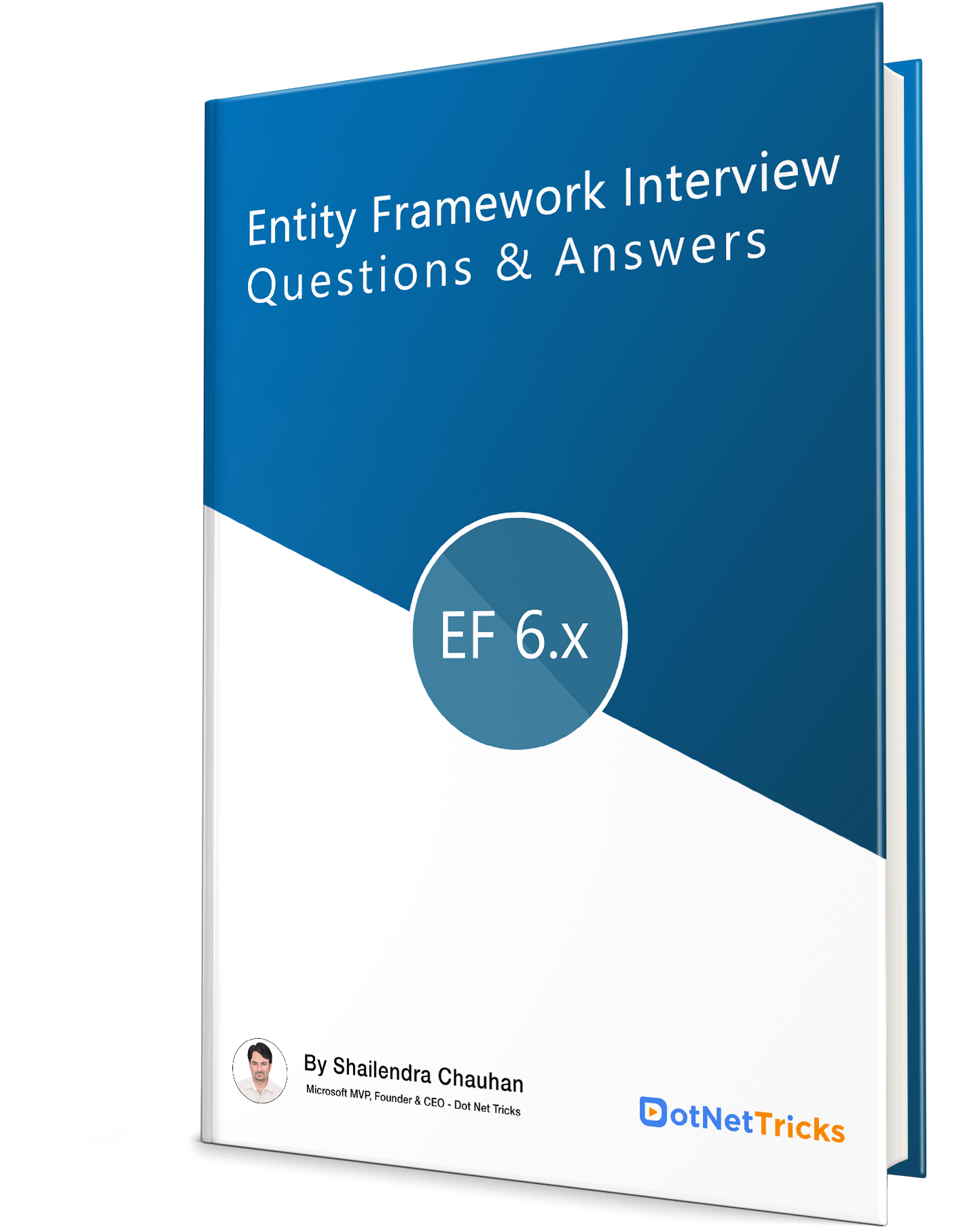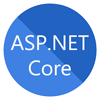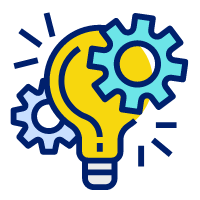18
AprTop 50 Entity Framework Interview Questions & Answers
Entity Framework Interview Preparation: An Overview
ADO.NET Entity Framework is an open-source ORM framework that allows you to query the database in an object-oriented fashion. It works with. NET-based applications and internally wraps ADO.NET. This article contains Best Entity Framework Interview Questions & Answers.
Prepare yourself for the interview with the help of the ADO.NET Core interview question answer the PDF file and get a suitable development position on the cloud-based application including web application, IoT application, and Mobile application. So, If you want to win in Azure DevOps interview. Go through these Azure DevOps Interview Questions and Answers once.
Entity Framework Interview Questions & Answers
-
What is ADO.NET Entity Framework?
ADO.NET Entity Framework is an ORM framework that empowers developers to work with various relational databases like SQL Server, Oracle, DB2, MYSQL, etc. It allows developers to deal with data as objects or entities. Using the Entity Framework, developers issue queries using LINQ, then retrieve and manipulate data as strongly typed objects using C# or VB.NET Framework.
-
What other O/RMs you can use with .NET-based applications?
The following O/RMs, you can use with .NET-based applications:
-
Entity Framework 6.x
-
Entity Framework Core
-
Dapper
-
N Hibernate
-
-
What are Micro O/RMs?
A Micro ORM is architected to focus on the most important task of working with database tables instead of creating, modifying the database schema, tracking changes, etc. EF 6.x and EF Core both are O/RMs since they provide a full set of features.
-
What is Dapper?
Dapper is a simple/ micro ORM for the .NET world. Dapper was created by the StackOverflow team to address their issues and open-source it. It's a NuGet library that can be added to any .NET project for database operations.
-
What is an SQL injection attack?
A SQL injection attack is an attack mechanism used by hackers to steal sensitive information from the database of an organization. It is the application layer (means front-end) attack that takes benefit of inappropriate coding of our applications that allows a hacker to insert SQL commands into your code that is using SQL statements.
SQL Injection arises since the fields available for user input allow SQL statements to pass through and query the database directly. SQL Injection issue is a common issue with an ADO.NET Data Services query.
-
How to handle SQL injection attacks in Entity Framework?
Entity Framework is injection safe since it always generates parameterized SQL commands which help to protect our database against SQL Injection.
An SQL injection attack can be made in Entity SQL syntax by providing some malicious inputs that are used in a query and in parameter names. To avoid this, you should never combine user inputs with Entity SQL command text.
-
What are various approaches to domain modeling in Entity Framework?
There are three ways to approach Entity Framework:
1. Database-first: If we start with a database, Entity Framework generates the code.
2. Model-first: If we start with a visual model, Entity Framework generates both the database and code.
3. Code-first: If we start with code, Entity Framework generates the database.
-
What are POCO classes?
The term POCO does not mean to imply that your classes are either plain or old. The term POCO simply specifies that the POCO classes don’t contain any reference that is specific to the entity framework or .NET framework.
POCO (Plain Old CLR Object) entities are existing domain objects within your application that you use with Entity Framework.
-
What is the proxy object?
An object that is created from a POCO class or entities generated by the Entity Framework to support change tracking and lazy loading, is known as a proxy object.
There are some rules for creating a proxy class object:
-
The class must be public and not sealed.
Each property must be marked as virtual.
Each property must have a public getter and setter.
Any collection navigation properties must be typed as ICollection <T>.
-
-
What are the various Entity States in EF?
Each and every entity has a state during its lifecycle which is defined by an enum (EntityState) that has the following values:
-
Added
-
Modified
-
Deleted
-
Unchanged
-
Detached
-
-
What are the different types of inheritance in Entity Framework?
Inheritance in the Entity Framework is similar to inheritance for classes in C#. In Entity Framework, you can map an inheritance hierarchy to single or multiple database tables based on your requirements. EF supports three types of inheritances:
-
Table-per-Hierarchy (TPH)
-
Table-per-Type (TPT)
-
Table-per-Concrete-Type (TPC)
-
-
What are the various approaches in Code First for model designing?
In Entity Framework Code First approach, our POCO classes are mapped to the database objects using a set of conventions defined in Entity Framework. If you do not want to follow these conventions while defining your POCO classes, or you want to change the way the conventions work then you can use the fluent API or data annotations to configure and to map your POCO classes to the database tables. There are two approaches, which you can use to define the model in EF Code First:
-
What C# Datatype is mapped with which Datatype in SQL Server?
The following table has the list of C# Datatype mapping to the corresponding SQL Server Datatype:
C# Data TypeindexOf()intintstringnvarchar(Max)decimaldecimal(18,2)floatrealbyte[]varbinary(Max)datetimedatetimeboolbitbytetinyintshortsmallintlongbigintdoublefloatcharNo mappingsbyteNo mappingobjectNo mapping -
What is Code First Migrations in Entity Framework?
The code-firstapproach allows you to define model classes as per the Domain requirements via POCOs. Hence, you have complete control over the classes being written or Implemented.
Code First Migrations allows you to create a new database or to update the existing database based on your model classes by using the Package Manager Console that exists within Visual Studio.
-
What is the Migrations History Table?
In EF6, the Migrations history table (__MigrationHistory) is a part of the application database and is used by Code First Migrations to store details about migrations applied to a database. This table is created when you apply the first migration to the database. This table stores metadata describing the schema version history of one or more EF Code First models within a given database. In EF 5, this table was a system table when you use the Microsoft SQL Server database.
In EF 5, this table was a system table when you use the Microsoft SQL Server database.
-
What is automatic migration?
IEntity Framework supports automatic migration so you don't need to migrate model changes manually. So, when you will run the application, it will be handled by the EF.
-
What is DbSet?
DbSet is a typed entity set that is used to perform create, read, update, and delete operations on a particular entity. DbSet can only be created from a DbContext instance. DbSet does not support the Entity SQL methods.
-
What is ObjectSet?
ObjectSet is a typed entity set that is used to perform create, read, update, and delete operations on a particular entity. ObjectSet is can only be created from an ObjectContext instance. ObjectSet does not support the Entity SQL methods.
-
How to execute plain SQL in EF6?
EF6 allows us to execute raw SQL queries to query the database. The following methods are used to execute raw SQL queries:
-
DbSet.SqlQuery()
-
DbContext.Database.SqlQuery()
-
DbContext.Database.ExecuteSqlCommand()
-
-
How does EF support Transaction?
In EF, whenever you execute SaveChanges() to insert, update, or delete data into the database, it wraps that operation in a transaction. So, you don’t need to open a transaction scope explicitly.
Q21.What are the features of Entity Framework?
Querying, Cross-Platform, Modeling, Saving, Change tracking, Concurrency, Caching, Transaction, Configuration, Built-in conventions, and Migrations. These are the features of Entity Framework.
Q22.What is the purpose of the conceptual model?
The conceptual model is also called the Conceptual Data Definition Language Layer or C-Space. It contains the entities/model classes and also their relationships. This all thing doesn't affect our database table design. Because It ensures that business objects and relationships are demarked in XML files.
Q23. What is the purpose of the mapping model?
The mapping model is also called the Mapping Schema Definition Language layer or C-S Space. It includes information about the mapping of the conceptual model to the storage model. You can say that this model maps the business objects and their relationships at the conceptual layer to tables and relationships at the logical layers.
Q24.What is the purpose of the storage model?
The storage model is also called the Store Space Definition Language Layer or S-Space. The storage area in the backend is always represented by this model. That's why it's also called the database design model composing stored procedures, keys, views, tables, and related relationships.
Q25.What is meant by migration in Entity Framework?
The Entity Framework introduced the migration tool for automatically updating the database schema. There are two types of migration provided by Entity Framework automated migration and code-based migration.
Q26.What does the .edmx file contain?
By using the EDMX files, Classes can be automatically generated to interact within the application. EDMX file represents the conceptual models, storage models, and the mappings. All information about SQL objects and tables is contained in it. The crucial information needed to render models graphically with ADO.NET is also contained. Its 3 types are MSL, CSDL, and SSDL.
Q27.Mention some XML generation methods that the dataset object provides.
The below methods are provided by Dataset objects to generate XML:
1.GetXml(): A string containing an XML document is provided by this method.
2.ReadXml(): an XML document is read into a Dataset object by this method.
3. Write XML (): The XML data is written to disk by this method.
Q28.Why is the T4 entity important in the Entity Framework?
T4 files are crucial in the code generation of Entity Framework. T4 code templates are used to read the EDMX XML files. The C# behind the code is then generated by the T4 files. Just entity and the context classes are contained in the generated C# behind the code.
Q29.What is meant by the navigation property in Entity Framework?
It represents a foreign key relationship in Entity Framework's database. The relationships between the entities in a database can be specified with the help of this property type. In object-oriented programming, the relationships are defined such that they remain coherent.
Q30.What is meant by deferred execution in Entity Framework?
We can wait for the evaluation of any expression till the time we want its realized value to appear. Hence we can improve the performance significantly by avoiding unnecessary execution. Until the query object or query variable iterates over a loop, queries get deferred.
Q31.What do you mean by database concurrency?
It arises when multiple users are accessing and modifying the same data simultaneously in the same database. Concurrency controls keep the consistencyof data protected in such situations.
Q32.How can you handle database concurrency?
You can implement optimist locking to handle the database concurrency. You can implement the locking by right-clicking on the EDMX designer and setting the concurrency model to Fixed. If any case any concurrency issue exists, a positive concurrency exception error arises.
Q33.Explain SSDL, CSDL, and MSL divisions in an EDMX file.
1. SSDL stands for Storage Schema Definition Language. Mapping to RDBMS data structure is defined in this division.
2. CSDL stands for Conceptual Schema Definition Language. It is an app that exposes conceptual abstraction. The model object's description can be obtained in this division.
3. MSL stands for Mapping Schema Language. MSL connects CSDL and SSDL. Or we can say that it maps the model to the storage.
Q34.Explain the terms dbset and dbcontext.
1. dbset-operations can be created, updated, read, and deleted on any entity set in a dbset class. We must include the dbset type properties mapping to the database tables and views in the context class (from dbcontext).
2. dbcontext- It is an important class in Entity Framework API. This is used to connect a domain class or entity and the database. Its main responsibility is to communicate with the database.
Q35.What is meant by the Object Set in Entity Framework?
An object set is a specific type of entity set that can be used to read, update, create, and remove operations from any existing entity. It can only be created by using an Object Context instance. It does not support any kind of Entity SQL method.
Q36.Explain the eager loading, lazy loading, and explicit loading in detail.
1. Eager loading:In this loading, all the related objects are also returned along with the object's query. All related objects get loaded automatically along with the parent object. You can achieve eager loading in EF 6 by using the Include method.
2. Explicit loading: This loading occurs only when we desire lazy loading. The relevant load method should be explicitly called for processing explicit loading. We can achieve explicit loading in EF 6 by using the load method.
3.Lazy loading: This loading process of related objects is delayed till the time we need them. Only objects you need are returned in the lazy loading. Simultaneously, the other related objects get returned only when we need them.
Q37.Explain the role of singularizing and pluralizing in the Entity Framework.
The important responsibility of singularizing and pluralizing in Entity Framework is assigning the objects meaningful naming conventions. This feature can be processed through the .edmx file. The coding conventions will assigned to the singular and plural while this feature is used. The convention names have an extra 's' if there are two or more than two records within an object.
Q38.What is meant by micro O/RMs in Entity Framework?
The micro ORM is not made to create database schemas, track changes, modify database schemas, etc. Instead, it is primary function is to work with database tables. Because Entity Framework Core and Entity Framework 6 have a complete set of functionalities and features, they are referred to as O/RMs.
Q40.What is meant by Optimistic Locking?
It is the process of reading a record and noting a version number, timestamp, date, or hash. Then, you can check that the record hasn't changed before writing the code back. While writing the record back, we filter the update on the version, ensuring that it's atomic. Then the version is updated in a single hit.
Q41.How does EF support transactions?
In Entity Framework, whenever we perform Save Changes () to put in, modernize, or delete data into the database, it wraps that process in a transaction.
Q42.Which namespace is used for the inclusion of the .NET data provider for the SQL server in your .NET code?
We use namespace as - System.Data.SqlClient for the inclusion of a .NET data provider for SQL server in our .NET code.
Q43.When should modeling entry approaches be used?
The Code First approach is better when we have the domain classes already with us. On the other hand, the Database First approach is the right fit when we have a database. And the Model First approach is used when we don't have any database or model classes.
Q44. Mention the primary functions of the Entity Framework.
EF enables the mapping of domain classes to the database schema. EFAlterations in the entities are kept on track.EF enables the execution of LINQ queries to SQL. In EF the changes in stats are stored in the database.
Q45.What are the advantages of the Model First Approach?
Model First Approach provides flexibility for designing the Entity Models separately and offers options to improve them in further stages. This approachdoes not use many databases because we can create model classes by drawing them using the EDMX designer.
Q46.Which, according to you, is the best approach in the Entity Framework?
There is no special approach that can be referred to as the best approach in Entity Framework. The selection of the approaches primarily relies on the project requirements and the project's types. If there is the database's existence, then it is good to use the Database First approach. If there is no database and the model classes, then the model-first approach is the best selection. If there is the availability of the domain classes, the Code-First approach is the most suitable choice.
Q47.What do you understand by LINQ to Entities?
It is defined as one of the popular query languages in Entity Framework. It mainly helps write queries against the objects to retrieve entities based on the conceptual model's definitions.
Q48.What do you understand by the Entity SQL?
It is an alternate query language that is similar to a LINQ for Entities. However, it is complicated than LINQ to Entities. Programmers who want to use this language will have to learn it separately.
Q49.How would you handle large volumes of data using Entity Framework?
Entity Framework can handle large data volumes through various strategies. One approach is to use the As NoTracking method, which prevents Entity Framework from tracking changes in entities, reducing memory usage and improving performance. The second strategy involves using stored procedures for complex queries or operations, as they are faster than LINQ queries.
Q50.What do you know about ComplexType in Entity Framework?
ComplexType is a non-scalar property of entity types. This type helps users to assign scalar relationships between entities.
| Download this PDF Now - Entity Framework Interview Questions PDF By ScholarHat |
- Summary:
I hope these questions and answers will help you to crack your Entity Framework Interview. These interview Questions have been taken from our newly released eBook Entity Framework 6. x Questions and Answers. This book contains more than 110 Entity Framework interview questions.
This eBook has been written to make you confident in Entity Framework with a solid foundation. Also, this will help you to turn your programming into your profession. It would be equally helpful in your real projects or to crack your Entity Framework Interview.










